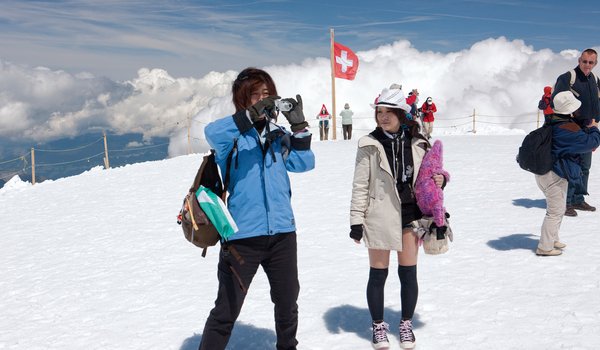Opportunities and risks
The Jungfrau Railway was built at the turn of the 20th century. Since its inauguration on 1 August 1912, the highest railway station in Europe has been located on the Jungfraujoch, at 3,454 metres above sea level – the Top of Europe. Due to the unique mountain scenery of the Eiger, Mönch and Jungfrau, as well as the touching construction history involving railway pioneer Adolf Guyer-Zeller, the journey on the Jungfrau Railway is a unique attraction in the Alps with a worldwide appeal.
The consistently high demand for tourism forms the basis for the global positioning and marketing of the Jungfraujoch – Top of Europe. UNWTO, the tourism organisation of the United Nations, puts the worldwide growth in arrivals at 3.9% in 2016. This was the seventh year in a row with an increased tourism demand. UNWTO also expects a continuation of this trend in 2017. [1]
In Switzerland, arrivals remained more or less constant over the same period. However, visitor numbers from China have declined significantly (-22%). This market has been among the most important of the Jungfrau Railway for the last few years. By way of contrast, the number of overnight stays of guests from other Asian countries, such as Japan, India and Korea, remained stable. In the Bernese Oberland, arrivals and overnight stays, with a 1% reduction in available hotel beds, saw an overall drop of 3% compared to the previous year. The number of visitors to the Jungfraujoch has responded to this development in demand potential. The extraordinary figures of 2015, with one million visitors on the Jungfraujoch, which was mainly due to a surge in the Chinese segment, could not be repeated. With its second best result, the company has returned to the medium-term growth path (see Jungfraujoch visitors). Viewed over the course of several years, it is striking that the Jungfrau Railway was able to take disproportionate advantage of the tourism potential of Switzerland with regard to Jungfraujoch visitors.
Chart comparison of overnight stays / arrivals at Jungfraujoch
As a pioneer on the Asian markets, the Jungfrau Railways Group already recognised the potential of Asia decades ago. The entire Jungfrau Region benefited from this, particularly in the last ten years. Today, the broad anchorage in Germany, in Europe and in various countries and economic areas in Asia protects against excessive demand fluctuations (volatility of the tourism industry). This explains why the aforementioned negative swing in the number of arrivals from China – a result of the accumulation in 2016 of various negative effects such as fear of terrorism, more elaborate visa administration and restructuring of the tour operator industry – did not have a stronger impact on Jungfraujoch visitor numbers. In addition, other countries such as Japan, India or Korea as well as Southeast Asia in general have had a stabilising effect.
In the strategic risk analysis, the opportunities arising from the unique position of the Jungfraujoch and the particular reputation of Switzerland contrast with the risks of tourism demand. Behind these dangers are general factors such as currency fluctuations, the geopolitical security situation and the threat of terror. Due to overcapacity in its own ranks, driven by a subsidy policy in all Alpine regions, and the global offer of alternative leisure facilities, the mountain railway industry is facing increasing price pressure.
The time requirement or time loss is an important quality factor in the modern tourism industry. Experienced travellers dislike long transfers without any experience value as much as skiers dislike long queues in front of the valley station where they will spend a valuable part of their skiing holiday. Speed, capacities and optimum utilisation are therefore among the production factors that represent a weakness of the mountain railways originating from the pioneer days. The Jungfrau Railways Group is paying particular attention to this area. Ongoing improvements could be achieved, for example, by more powerful traction units, by the construction of double lane tracks on the Wengernalp Railway or by a sophisticated reservation system at the Jungfrau Railway. Another advantage in terms of comfort is the realisation of the V-Cableway. This major project will secure the medium and long term successful future of tourism throughout the entire Jungfrau Region as a vital year-round destination in Swiss tourism. This project is presented separately in detail in the management report.
